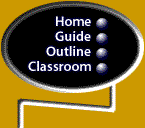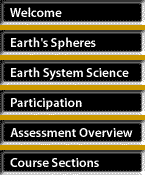 |
 |
 |
 |

Final Project Assignment
& Rubric-Individual
Week 16
Goals:
To design an Earth system science unit plan, and to provide a rationale
for why you designed your unit plan the way you did.
Background:
In the previous weeks, you have created sphere lessons for land, living
things, air, and water from an Earth system science perspective. Now you
need to weave these lessons into a unit plan so that students who have
a background in each sphere can apply what they have learned to a greater
understanding of earth's interacting systems.
To weave your four sphere lessons
into a unit plan, you need to create a unifying essential question, problem/puzzle,
situation, experiment, or simulation for students to address. This unifying
element will appear in the introduction of your Earth system science unit
plan. This unit plan will give students a reason to study the spheres
through an Earth system science approach in order to understand how each
of the spheres affects one another. The questions below may help you to
identify a question or problem which will unify your unit plan design.
- What are the most powerful
ideas about each of the four spheres and their relationships in Earth
System Science terms?
- What are the most accessible
of these powerful ideas for my students?
- What are the gaps in my
knowledge of these spheres in an Earth System Science context?
- What is it about these ideas
that my students will find intriguing, puzzling, interesting, or applicable
to their lives?
- What prior knowledge and
experience do my students have that may give rise to their misconceptions
which need to be confronted before their knowledge can grow?
The following examples may
give you some ideas of how you can unify your unit plan.
essential question:
Based on what you have learned about the four spheres, what conditions
would need to be present for a garden to grow well in front of your school?
problem/puzzle: A section
of the playground near the slide is eroding. The principal has asked your
class to investigate the problem and to propose a solution based on your
knowledge of the four spheres.
situation: The annual
school picnic is scheduled for May 23. Your class is in charge of the
environment. Based on your knowledge of the four spheres, plan for a successful
event at this time of year. Include plans for the land, the air temperature,
precipitation, etc.
experiment: Create terrariums
for different biomes and do experiments to compare them. Using what you
have learned about the four spheres, what factors need to be present for
the plants and animals to continue living in the terrariums?
simulation: Choose a
destination of some place you would like to visit. Consider what you have
learned about the four spheres, then pack a bag of things to take with
you on your trip that would be appropriate for that location.
In addition, you will provide
a rationale for your unit plan design stemming from your action research,
scholarship, and sphere lesson design experiences as well as your collaboration
with teammates. Your reflections on the questions below may help you to
focus your rationale.
- How does the activity draw
out what students already know and are able to do?
- How does the activity help
students rethink and re-examine what they know?
- How is evidence of student
learning generated during and after the activity?
Use the directions below to
complete this week’s individual assignment.
|
Assignment
(by midnight
Sunday)
Posting Instructions
for steps 1-4
Go
to the Classroom, then
to Teacher As Designer. |
1. Create a unifying
essential question, problem/puzzle, situation, experiment, or simulation
for students to address. This unifying element should appear in
the introduction of your Earth system science unit plan.
2. Develop your
unit plan.
3. Provide a rationale.
4. Use
the rubric below to critique your teammates’ unit plans.
Posting Instructions
for step 5
Go
to the Classroom, then to Portfolio Space. |
5. Go
to your portfolio in the Classroom to make links from your portfolio
to your final project.
|
Rubric
You and your
facilitator will use the rubric below to gauge your success in developing
a unit plan. These criteria will serve as the basis upon which your unit
plan AND your Portfolio reflections and your rationale for the unit plan's
design and content will be evaluated. You should also use these criteria
to give your teammates feedback on their unit plans.
| Rubric
Criteria: Unifying
question, problem or theme. |
4
Rating:
Unifying
approach compels students to develop their understanding of ESS.
|
3
Rating:
Unifying
approach builds ideas that are powerful and provocative to students
in ESS.
|
2
Rating:
Unifying
approach engages students in investigating Earth systems.
|
1
Rating:
Unit
purpose is clear in the unifying approach used. |
| Rubric
Criteria: Activities
that engage students. |
4
Rating:
Activities cause
students to state and question their thinking.
|
3
Rating:
Activities
push student thinking beyond misconceptions.
|
2
Rating:
Activities
make student thinking about misconceptions visible. |
1
Rating:
Activities
make student thinking visible. |
| Rubric
Criteria: Outcomes
assessment. |
4
Rating:
Assessment
is ongoing and standards-based, and involves students in setting their
own goals and seeing their own growth.
|
3
Rating:
Assessment
begins with students'
ideas about the initial situation, question, or problem and tracks
what they learn over time.
|
2
Rating:
Assessment
shows changes in students'
conceptions of Earth system science. |
1
Rating:
Assessment
is ongoing and standards-based. |
| Rubric
Criteria: Reasons
for instructional design (goals, unifying approach, resources, assessment...).
|
4
Rating:
Design
decisions are supported with evidence from multiple sources, including
personal action research as well as scholarship and peer feedback. |
3
Rating:
Design
decisions are supported with evidence from at least one source, including
personal action research, scholarship, or peer feedback.
|
2
Rating:
Design
decisions are sound but not well-supported.
|
1
Rating:
Design
is complete, but elements are not unified. |
[ Back
]
[
Welcome ] [Earth's Spheres
] [ Earth System Science ] [ Participation
]
[ Assessment Overview ] [ Course
Sections ]
[
Home ] [ Guide
] [ Outline ] [
Classroom ]
|
 |
 |




|
 |